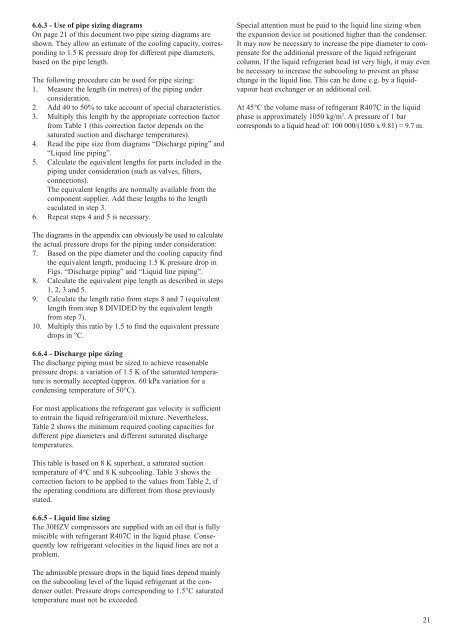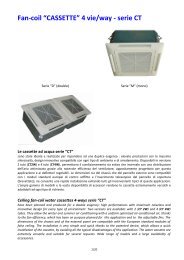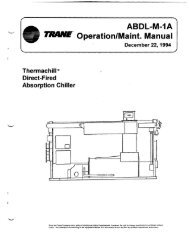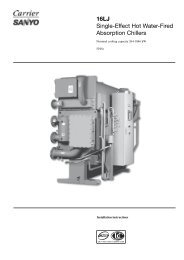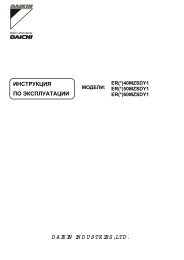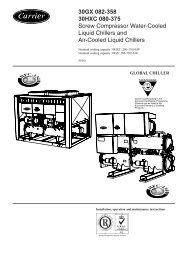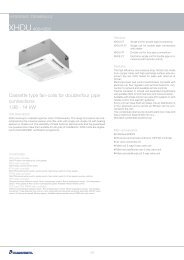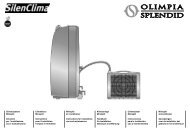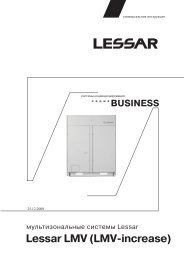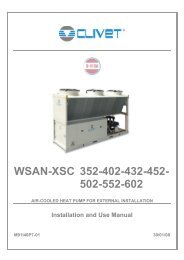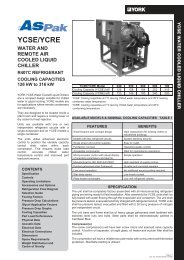6.4.2 - Pipe connectionsAfter welding the pipes to the flanges previously removedfrom the water boxes:1. Reinstall the pipes and tighten lightly to a torque at thelow end of the range.2. Fill the system with water.3. Wait for 10 minutes and check for minor leaks- at the water box joints- at the flange joints4. Drain the system.5. Disconnect the pipework.6. Tighten the head bolts to their final torque (middle of therange) in the sequence illustrated.7. Reconnect the water pipes, tightening the flange bolts tothe mid-range torque value.8. Refill the system with water.9. Pressurize the system.6.5 - Frost protectionThe <strong>30HZ</strong> and <strong>30HZ</strong>V units are designed to be installed undercover at outside temperatures between +5°C and +40°C.Therefore they do not include anti-freeze protection, as standard.If the water piping is in an area where the ambient temperaturecan fall below 0°C it is recommended to install a trace heater onthe piping and to add an antifreeze solution to protect the unitand the water piping to a temperature of 10 K below the lowesttemperature likely to be reached at the installation site. Useonly antifreeze solutions, approved for heat exchanger duty. Ifthe system is not protected by an antifreeze solution and willnot be used during the freezing weather conditions, draining ofthe cooler and outdoor piping is mandatory. Damage due tofreezing is not covered by the warranty.IMPORTANT: Depending on the climatic conditions in yourarea you must:- Add ethylene glycol with an adequate concentration toprotect the installation up to a temperature of 10 Kbelow the lowest temperature likely to occur at theinstallation site.- If the unit is not used for an extended period, it isrecommended to drain it, and as a safety precaution addethylene glycol to the heat exchanger, using the waterentering purge valve connection.At the start of the next season, refill the unit with waterand add an inhibitor.- For the installation of auxiliary equipment, the installermust comply with basic regulations, especially forminimum and maximum flow rates, which must bebetween the values listed in the operating limit table(application data).6.6 - Refrigerant line connections (<strong>30HZ</strong>V)6.6.1 - Recommendations for the installation of liquidchillers with remote condensersTo guarantee optimum and reliable performance of the <strong>30HZ</strong>Vunits (split units for connection to condensers) it is necessaryto comply with the regulations described below, when theseunits are connected to remote condensers.1. Install a valve in the discharge piping (valves are factoryinstalledin sizes <strong>043</strong>-063, and supplied non-installed insizes 091-<strong>280</strong>).2. Size the discharge and liquid line piping according to therecommendations in the following paragraphs (if necessary,install a double riser to ensure correct oil circulationin the refrigerant circuit).3. Depending on the layout and the routing of the dischargepiping it may be necessary to install additional silencers(to reduce pulsations and noise emission) between theliquid chiller and the condenser.4. Select a condenser with an integrated subcooler to obtaina minimum of 3 K subcooling at the inlet to the expansiondevice.5. Keep the condensing pressure as stable as possible(pressostat staging or fan control via Pro-Dialog Plus). Aspeed controller may be required for the first fan stage foroperation at low ambient temperature and partial load.6. If the system can have several operating modes (summer/winter, dual set point etc.), it is necessary to install a tank(or receiver) to absorb the variations in charge.6.6.2 - GeneralRefrigerant pipe sizing must be carried out, taking account ofthe following constraints:Oil return to the compressor must be ensured for the majority ofapplications. Oil return is ensured by entrainment. A minimumrefrigerant velocity is required to ensure entrainment. Thisvelocity depends on the pipe diameter, the refrigerant and oiltemperature (these are treated as being the same in mostcases). A reduction of the pipe diameter permits an increase ofthe refrigerant velocity. The problem of a minimumentrainment velocity does not exist for the pipes that carryliquid refrigerant as the oil is fully miscible here.The pressure drop at the compressor discharge (pipes linkingthe compressor outlet with the condenser inlet) must be limitedto avoid system performance losses (the compressor powerinput inceases, and the cooling capacity decreases).As a first estimate and for standard air conditioning applications,a one degree Celsius pressure drop on the discharge sidedecreases the cooling capacity 2% and increases the compressorpower input by 3%. Increasing the pipe diameter permitslimiting the pressure drops.The pressure drop in the liquid line (linking the condenseroutlet to the expansion device) must not result in a change inphase. The estimate of these pressure drops must include thosefor the possible accessories, such as solenoid valves, filters,filter drier, etc.20
6.6.3 - Use of pipe sizing diagramsOn page 21 of this document two pipe sizing diagrams areshown. They allow an estimate of the cooling capacity, correspondingto 1.5 K pressure drop for different pipe diameters,based on the pipe length.The following procedure can be used for pipe sizing:1. Measure the length (in metres) of the piping underconsideration.2. Add 40 to 50% to take account of special characteristics.3. Multiply this length by the appropriate correction factorfrom Table 1 (this correction factor depends on thesaturated suction and discharge temperatures).4. Read the pipe size from diagrams “Discharge piping” and“<strong>Liquid</strong> line piping”.5. Calculate the equivalent lengths for parts included in thepiping under consideration (such as valves, filters,connections).The equivalent lengths are normally available from thecomponent supplier. Add these lengths to the lengthcaculated in step 3.6. Repeat steps 4 and 5 is necessary.Special attention must be paid to the liquid line sizing whenthe expansion device ist positioned higher than the condenser.It may now be necessary to increase the pipe diameter to compensatefor the additional pressure of the liquid refrigerantcolumn. If the liquid refrigerant head ist very high, it may evenbe necessary to increase the subcooling to prevent an phasechange in the liquid line. This can be done e.g. by a liquidvapourheat exchanger or an additional coil.At 45°C the volume mass of refrigerant R407C in the liquidphase is approximately 1050 kg/m 3 . A pressure of 1 barcorresponds to a liquid head of: 100 000/(1050 x 9.81) = 9.7 m.The diagrams in the appendix can obviously be used to calculatethe actual pressure drops for the piping under consideration:7. Based on the pipe diameter and the cooling capacity findthe equivalent length, producing 1.5 K pressure drop inFigs. “Discharge piping” and “<strong>Liquid</strong> line piping”.8. Calculate the equivalent pipe length as described in steps1, 2, 3 and 5.9. Calculate the length ratio from steps 8 and 7 (equivalentlength from step 8 DIVIDED by the equivalent lengthfrom step 7).10. Multiply this ratio by 1.5 to find the equivalent pressuredrops in °C.6.6.4 - Discharge pipe sizingThe discharge piping must be sized to achieve reasonablepressure drops: a variation of 1.5 K of the saturated temperatureis normally accepted (approx. 60 kPa variation for acondensing temperature of 50°C).For most applications the refrigerant gas velocity is sufficientto entrain the liquid refrigerant/oil mixture. Nevertheless,Table 2 shows the minimum required cooling capacities fordifferent pipe diameters and different saturated dischargetemperatures.This table is based on 8 K superheat, a saturated suctiontemperature of 4°C and 8 K subcooling. Table 3 shows thecorrection factors to be applied to the values from Table 2, ifthe operating conditions are different from those previouslystated.6.6.5 - <strong>Liquid</strong> line sizingThe <strong>30HZ</strong>V compressors are supplied with an oil that is fullymiscible with refrigerant R407C in the liquid phase. Consequentlylow refrigerant velocities in the liquid lines are not aproblem.The admissible pressure drops in the liquid lines depend mainlyon the subcooling level of the liquid refrigerant at the condenseroutlet. Pressure drops corresponding to 1.5°C saturatedtemperature must not be exceeded.21


